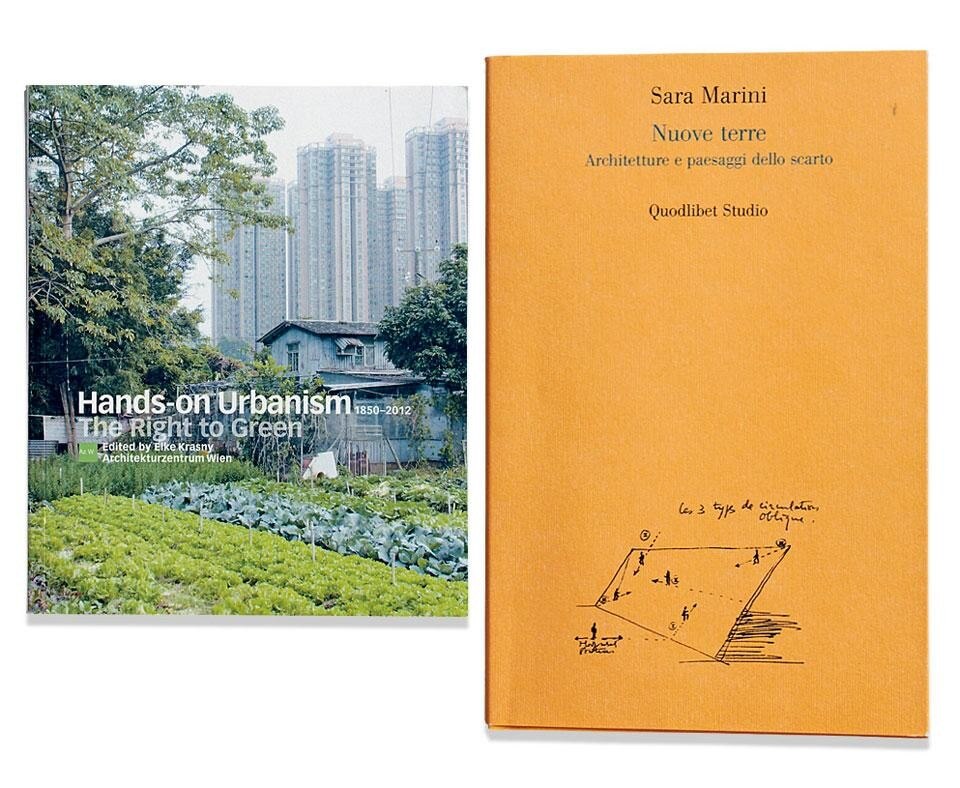Elke Krasny, Architekturzentrum Wien, Hands-on Urbanism 1850-2012. The Right to Green, MCCM Creations, Hong Kong 2012 (pp. 355, €30,00)
Sara Marini, Nuove terre. Architetture e paesaggi dello scarto , Quodlibet, Macerata 2010 (pp. 204, €17,00)
If we were talking about people we might use the
expression elective affinities: connections that are
difficult to define logically make the voice of one
person resonate in the meaning of another, and vice
versa, like when shared emotivity or idiosyncrasies
associate certain spirits, certain people. But here
we are talking about two books, whose similarities
are linked to the difficulty in placing them in a
disciplinary context. Both elude a precise definition,
arousing a curious fascination in the reader with the
inquiry method and the subject matter.
The first is by Sara Marini: Nuove terre. Architetture
e paesaggi dello scarto. Constructed like a powerful
collage on the theme of rejected, marginal and
abandoned places that traverse, touch and nourish
contemporary territories, it is the invention of a
cartographic science that is made up of stories
aiming to detect the discomforts and dreams of
our civilisation. Marini's choice of methodology
validates her systematic return to a subject that
she has been exploring now for several years
with decidedly positive results. Her "here and
now" regards a subject that is difficult to describe
and tends to be fleeting, because it is residual,
parasitical, elusive and unpredictable. The leftover
scraps that she describes belong to a system of
voids and omissions. It is a state of removal from
reality that claims to be physical; a phantom that
speaks, perfectly harmonised inside the book,
through the voices of philosophers, architects,
intellectuals, critics and artists.
Elective affinities
Spirit of enquiry and brilliant curiosity are common denominators of two books with a personality difficult to pigeon-hole: about marginal and abandoned places, and about green areas in our modern cities.

View Article details
- Elisa Poli
- 19 October 2012

The complex task of shaping the text is achieved via a subtle and continuous composition of pieces scientifically edited, with the form kept under tight and coherent control. The words, the discourse of the many authors cited inside the work, make up for a lack of iconography and symbolism that is inherent to the subject. The abandoned, leftover landscapes that the author refers to acquire life and visibility by means of conceptual operations that focus on their meaning. "I would like to verify here," she reminds us in the preface, "the possibility that design can reason differently, absorb the dynamics of time, and develop strategies which can annex, select, and abandon when necessary—basically enter into exchange with residual areas rather than exclude them beforehand as something that is improper material."
This variant of approach is found once again with the same coherence of intent in another book that is difficult to reduce to the dimension of a catalogue despite being distributed by the Architekturzentrum in Vienna as an appendix to a recent exhibition: Hands-On Urbanism 1859-2012. The book is edited by Elke Krasny to be a variegated journey of discovery of green areas—public, private, unauthorised, residual—that contribute to the construction of modern cities. The apparent parataxis of the text, which combines voices from quite a range of disciplinary spheres, threads during reading into a dense and stratified map that becomes a coherent and effective narration of geopolitical, sociological and anthropological urban aspects. It is a text that forces one to reconsider the superficial and simplistic mythology of urban allotments (and similar initiatives) in the light of attentive and serious historic research.
For a long time, urban greenery has been considered a design remnant of the city and at the same time its presence and the characteristic modalities of its occupation demonstrate how residual spaces are very often an opportunity for social responsibility, political proposals and design
Here, the residual element is acquired and reversed at the same time. For a long time, urban greenery has been considered a design remnant of the city and at the same time its presence and the characteristic modalities of its occupation demonstrate how residual spaces are very often an opportunity for social responsibility, political proposals and design. As the author reminds us in the introduction to the catalogue: "As we see, the garden is a contested territory, a battleground of regimes and ideologies." An interesting definition of gardens but also a hint for readers who are confronted with the spirit of exploration and brilliant curiosity that animate both books. Elisa Poli, co-founder of Cluster Theory